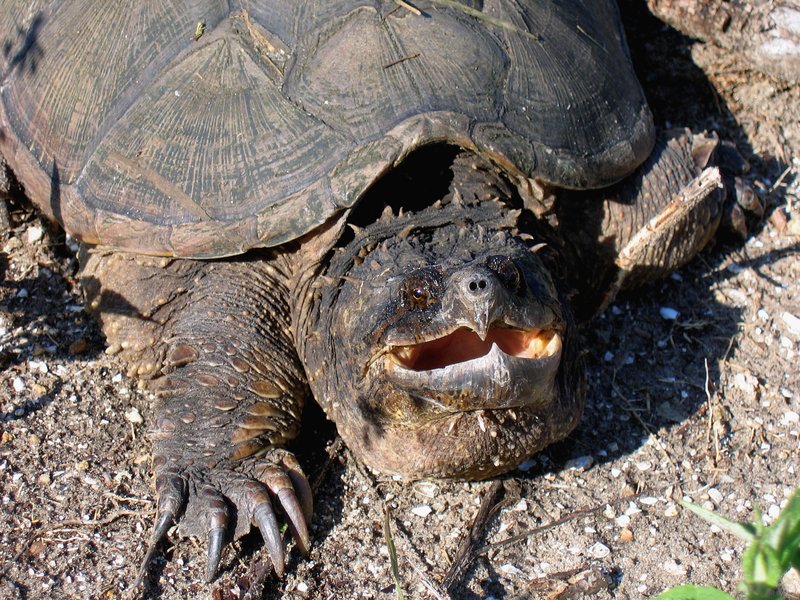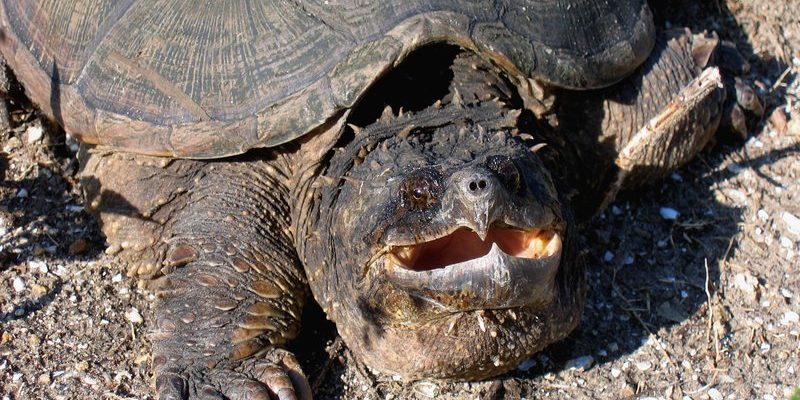
Let’s break down some common myths and facts about these fascinating reptiles. Snapping turtles are much more than just their fierce bite and intimidating appearance. Whether you’re curious about their lifestyle or need tips on how to appreciate them safely, there’s a lot to discover. So, grab your favorite coffee, and let’s dive into the world of snapping turtles together.
Myth 1: Snapping Turtles Are Aggressive
A lot of people think that snapping turtles are just waiting to snap at anything that comes near them. Here’s the thing: while snapping turtles can be defensive, they’re not out to get you. They’re simply responding to perceived threats.
For example, if you see one on the road and approach it, it might snap as a way to protect itself. In reality, snapping turtles prefer to avoid confrontation. They’d much rather swim away or hide in their shells if they feel threatened. So, if you spot one, it’s best to observe it from a distance.
This myth may come from their powerful bites. Adult snapping turtles have strong jaws that can bite through tough materials. However, just because they’re capable of that doesn’t mean they want to. Often, snapping turtles are just doing their best to go about their day!
Myth 2: Snapping Turtles Can Live Forever
You might have heard people saying that snapping turtles can live for over a hundred years. While they certainly have long lifespans, they’re not immortal. Typically, snapping turtles live around 30 to 40 years in the wild. In captivity, with the right care, they can live longer—sometimes even reaching 70 years.
Let me explain why this isn’t just a simple matter of age. Their lifespan is influenced by factors like habitat conditions, food availability, and threats from predators. In the wild, they face dangers like habitat destruction and pollution, which can shorten their lives. So, although they have impressive lifespans, they don’t live forever.
If you ever come across an old snapping turtle, consider how many challenges it has overcome to reach that age. It’s a testament to their resilience in a changing world!
Fact 1: Snapping Turtles Are Omnivores
One of the most interesting facts about snapping turtles is their diet. Unlike some turtles that strictly munch on plants or fish, snapping turtles are omnivores. This means they eat both meat and plants.
In their natural habitat, you might find them snacking on:
- Fish
- Crustaceans
- Aquatic plants
- Small mammals
- Insects
This variety helps them adapt to different environments. They aren’t picky eaters, which makes them excellent survivors in various habitats. Unfortunately, their feeding habits can also lead to conflicts with people, especially if they’re seen rummaging in backyard ponds or garden areas.
If you’re ever curious about what they’re eating, remember that they play a role in their ecosystems by controlling populations of prey species. This balance is essential for maintaining healthy environments.
Fact 2: They Have a Unique Breathing Method
You might be surprised to learn that snapping turtles have a unique way of breathing. They can hold their breath underwater for several hours. But what makes them even more fascinating is their ability to breathe through their butts—yes, you read that right!
Snapping turtles have a special structure called cloacal respiration. This allows them to absorb oxygen from the water through their cloaca, which is an opening they use for excretion. This means they can stay submerged longer without needing to surface for air, especially during winter months when they hibernate at the bottom of ponds or lakes.
Imagine having a superpower that allows you to multi-task while lounging in the water! This adaptation is crucial for survival, and while it sounds unusual, it’s a brilliant way for these turtles to thrive.
Myth 3: Snapping Turtles Are Bad Pets
Another common belief is that snapping turtles should never be kept as pets. While it’s true that they require specific care and can be challenging to manage, saying they’re bad pets isn’t entirely accurate.
If you’re considering adopting a snapping turtle, it’s vital to do your homework first. They need a suitable habitat with clean water, proper food, and enough space. Unlike small turtles, snapping turtles can grow significantly and may need large tanks or ponds. Also, they can be aggressive, so they aren’t the best choice for families with small children or pets.
On the flip side, if you’re committed and prepared for the responsibility, they can be unique companions. Just remember, like any pet, they deserve love and proper care to thrive.
Fact 3: Their Shells Are Strong but Vulnerable
You might think that a snapping turtle’s shell is indestructible, thanks to its toughness and size. While they do have strong shells for protection, they’re not completely invulnerable.
The shells are made of bony plates covered with keratin (the same stuff as our nails). This protects them from many predators, but not all. For instance, young snapping turtles are particularly vulnerable to larger birds and other animals. Even as adults, their shells can suffer from injuries due to human activities like boat collisions or pollution.
This is another reason why it’s essential to respect their habitats. When people litter or disturb their environments, it puts these magnificent creatures at risk.
At the end of the day, snapping turtles are fascinating creatures that deserve our respect and understanding. By debunking myths and sharing facts, we can appreciate these reptiles for what they truly are: resilient survivors of nature. Whether you encounter them in the wild or learn about them in your backyard, take a moment to admire their grace and adaptability.
So, next time you hear someone mention snapping turtles, you’ll be ready to share what you know! Remember, they’re not just the fearsome creatures we often think they are. They’re important members of our ecosystems, and they play vital roles in the balance of nature. Let’s work together to protect their habitats and ensure these remarkable beings continue to thrive for generations to come.

